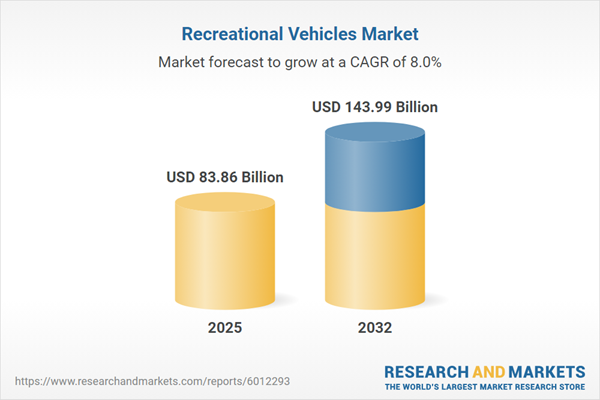Speak directly to the analyst to clarify any post sales queries you may have.
The recreational vehicles market is experiencing significant transformation as changing consumer expectations, advanced technologies, and shifting travel habits redefine the landscape. Stakeholders face mounting pressure to deliver sustainable, connected, and customized products while adapting to regional, regulatory, and supply chain dynamics.
Market Snapshot: Size and Growth Dynamics
The recreational vehicles market grew from USD 77.55 billion in 2024 to USD 83.86 billion in 2025. It is projected to expand further at a CAGR of 8.04%, reaching USD 143.99 billion by 2032. Strong economic performance, surging interest in experiential travel, and rapid adoption of new mobility solutions are key factors driving this upward trajectory. Market leaders are adjusting product portfolios and channel strategies to remain competitive in a diverse environment marked by accelerating demand and evolving consumer segments.
Scope & Segmentation
This report offers a comprehensive analysis of core market segments, regional dynamics, and emerging trends shaping the global recreational vehicles sector:
- End User: Private, Rental
- Propulsion Type: Diesel, Gasoline
- Vehicle Type: Motorhomes (Class A, Class B, Class C), Towables (Fifth Wheels, Pop-Up Campers, Travel Trailers, Truck Campers)
- Purchase Type: New, Used
- Distribution Channel: Direct Sales, Independent Dealers, OEM Dealerships
- Length: 21 To 30 Feet, 31 Feet and Above, Up To 20 Feet
- Region: Americas (North America, Latin America), Europe, Middle East & Africa, Asia-Pacific
- Companies Analyzed: Forest River, Inc.; Thor Industries, Inc.; Winnebago Industries, Inc.; REV Group, Inc.; Jayco, Inc.; Airstream, Inc.; Heartland Recreational Vehicles, LLC; KZ RV, LLC; Newmar Corporation; Tiffin Motorhomes, LLC
Throughout these segments, the report examines innovation, product development strategies, and shifts in consumer and operator behavior.
Key Takeaways for Decision-Makers
- Rising consumer preference for connectivity, sustainable design, and personalized travel is motivating rapid adoption of advanced telematics, modular interiors, and energy efficient systems across leading brands.
- Industry alliances between technology providers and established manufacturers are enabling faster deployment of smart features while supporting the transition to hybrid and electrified propulsion.
- The growing diversity of RV users, including multigenerational groups and urban consumers, is prompting a broader range of models and flexible ownership options, such as rentals and subscriptions.
- Service innovation is accelerating, with an emphasis on digital retail experiences and expanded aftersales support, from mobile maintenance fleets to predictive remote diagnostics.
- Strategic investments in regional manufacturing, digitized supply chains, and new materials are strengthening resilience against operational risks and helping organizations remain agile in competitive markets.
Tariff Impact: Navigating Cost and Supply Chain Pressures
The imposition of new U.S. tariffs in 2025 has increased complexity for recreational vehicles manufacturers and suppliers. Organizations are actively diversifying sourcing practices, shifting processes to lower-tariff regions, and redesigning products for modularity and regional compliance. Cost structures have shifted, requiring new retailer and aftermarket revenue models, alongside heightened supplier qualification efforts.
Methodology & Data Sources
This report employs structured interviews with sector executives, component suppliers, and end users as a foundation. Leading quantitative surveys validate qualitative findings. Comprehensive secondary analysis from trade publications, patent filings, and industry reports underpins all insights. Rigor in triangulation ensures data accuracy and unbiased recommendations.
Why This Report Matters to Senior Leaders
- Enables decisive resource allocation and market entry strategies aligned with emerging consumer trends and regulatory frameworks.
- Delivers actionable intelligence on new technologies, supply chain resilience, and regional opportunities.
- Empowers leaders to benchmark against competitors and identify high-growth segments within the recreational vehicles industry.
Conclusion
The recreational vehicles sector is undergoing fundamental change, driven by technology, regulation, and shifting consumer demand. Leaders who leverage forward-looking insights and adapt strategies to anticipate disruption will be best positioned for sustained, market-leading performance.
Additional Product Information:
- Purchase of this report includes 1 year online access with quarterly updates.
- This report can be updated on request. Please contact our Customer Experience team using the Ask a Question widget on our website.
Table of Contents
3. Executive Summary
4. Market Overview
7. Cumulative Impact of Artificial Intelligence 2025
Companies Mentioned
The companies profiled in this Recreational Vehicles market report include:- Forest River, Inc.
- Thor Industries, Inc.
- Winnebago Industries, Inc.
- REV Group, Inc.
- Jayco, Inc.
- Airstream, Inc.
- Heartland Recreational Vehicles, LLC
- KZ RV, LLC
- Newmar Corporation
- Tiffin Motorhomes, LLC
Table Information
| Report Attribute | Details |
|---|---|
| No. of Pages | 181 |
| Published | October 2025 |
| Forecast Period | 2025 - 2032 |
| Estimated Market Value ( USD | $ 83.86 Billion |
| Forecasted Market Value ( USD | $ 143.99 Billion |
| Compound Annual Growth Rate | 8.0% |
| Regions Covered | Global |
| No. of Companies Mentioned | 11 |









